If you’re searching for the perfect tree with heart-shaped leaves to add to your garden but feeling overwhelmed by the choices, you’re not alone.
Choosing the right tree with heart shaped leaves can be like solving a tricky puzzle, leaving you scratching your head. It is because there’s an overwhelming range of options, from blossoming beauties to color-changing marvels.
But your garden is hungry for pure excellence, a real showstopper. That’s where ornamental trees with heart-shaped leaves come into play. But hold on, the puzzle doesn’t stop there! It’s still unclear which trees have the most charming heart-shaped leaves.
In this blog post, we will share information about some beautiful trees with heart-shaped leaves.
So, if you’re eager to grow your own leafy heartthrobs, keep reading until the end.

Tree With Heart-Shaped Leaves | Zooming Out!
Trees with heart-shaped leaves are botanical wonders that have captured the fascination of plant lovers for generations.
They also go by names like cordiform or cordate-shaped leaves, which simply means a heart-shaped leaf with a:
Wide bottom
A gentle dip in the middle, and
A pointed tip
This unique shape sets them apart from the more common oval leaves.
When these unique leaves come together in clusters on a tree’s canopy, they create an enchanting and unique charm that truly highlights the individuality of each tree.
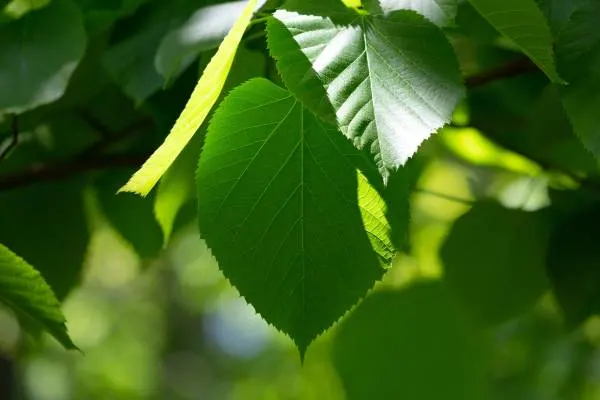
Tress with Heart-Shaped Leaves!
Heart-shaped leaves add a touch of charm to any garden.
Whether you prefer evergreen trees or deciduous shrubs, there are many options to choose from.
It’s important to keep in mind that every tree has its own specific needs, depending on the local climate and soil conditions.
Let’s explore how to nurture these trees to perfection.
1. American Lime
The American lime tree, botanically noun as Tilia americana, is a majestic addition to any landscape.
These deciduous trees are native to eastern and central North America, possessing heart-shaped leaves that are glossy dark green in color and create a stunning canopy that turns golden yellow in the fall.
However, what sets them apart is their exquisite, scented flowers that bloom in spring, attracting an array of pollinators, from bees to butterflies.
American lime not only offers beauty and shade but also serves as a hub of biodiversity, as the seeds they produce become a vital food source for birds and squirrels.
Characteristics
Here are a few plant characteristics:
Size: Up to 80 feet tall and 30–50 feet wide.
Hardiness Zones: Zones 2–8.
Light Requirements: American limes are truly versatile; they can bask in full sun or tolerate slight shade, making them adaptable to various garden settings.
Soil Preference: They prefer well-drained, loamy soil with a slightly acidic to neutral pH.
In the presence of the American lime tree, beauty and diversity come together, enriching your outdoor space with nature’s charm.
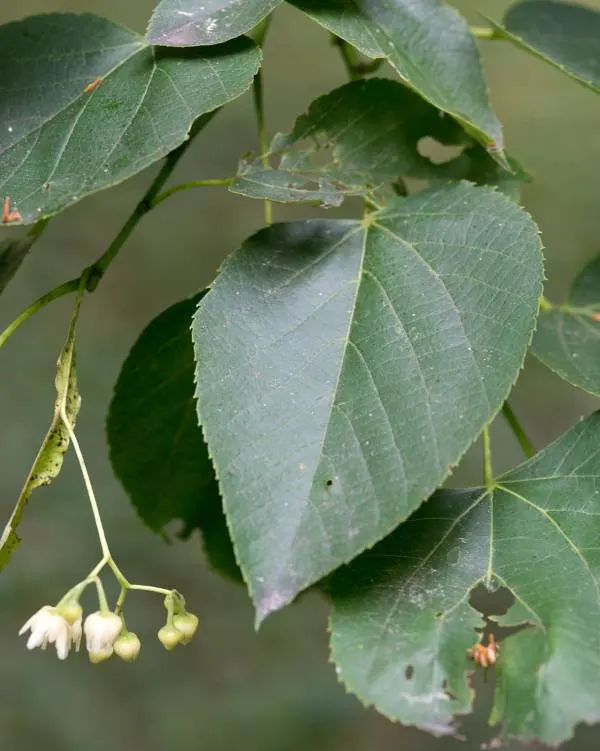
2. Empress Tree
The Empress Tree, also known as the Foxglove Tree or Princess Tree, is a captivating addition to any garden.
Originating from China, this deciduous beauty boasts heart-shaped leaves that provide a lush, green canopy.
In the spring, it bursts into fragrant lavender blooms, filling your garden with a delightful aroma similar to vanilla.
Characteristics
Here are some plant characteristics:
Size: Grow up to 80 feet in height and 30 feet in breadth
Hardiness Zone: Thrive in the USDA hardiness zones from 6 to 9
Light Requirements: It requires low maintenance, including full sun and moderate watering.
Soil: It is a hardy tree that can withstand poor soil types, air pollution, and drought.
In the garden’s fairy tale, the Empress Tree grows and shines as a symbol of nature’s beauty and fortitude.
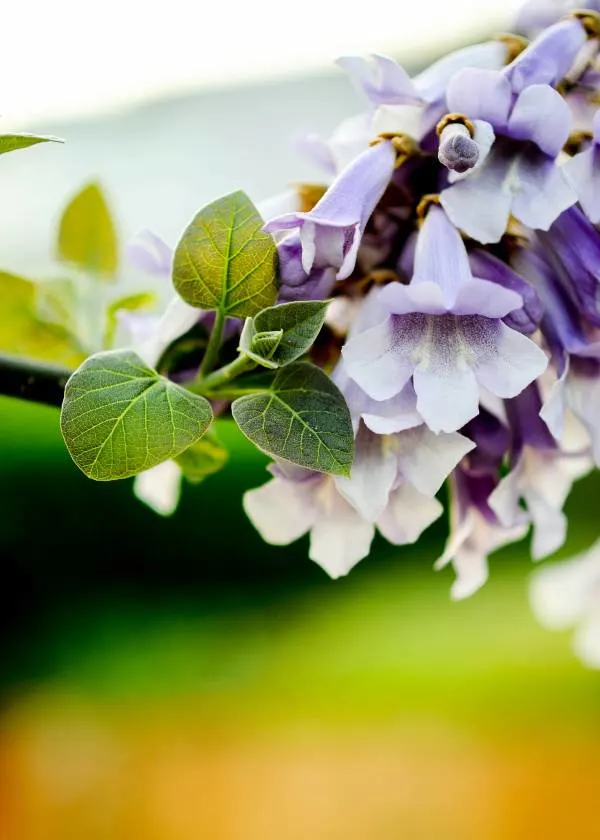
3. Hearts of Gold Redbud Tree
The Hearts of Gold Redbud tree, botanically called Cercis canadensis, is a real head-turner for any garden.
This deciduous tree possesses heart-shaped leaves that change from the striking orange-red in early spring to the final yellow-green, adding a touch of beauty to your surroundings throughout the year.
With a graceful, multi-stemmed growth habit, it creates a splendid canopy of dense foliage throughout.
So, why not bring this horticultural gem to your garden and enjoy its heartwarming presence?
Characteristics
Here are a few plant characteristics:
Size: 20–25 feet tall, 25–35 feet wide
Hardiness zones: 5–9
Light Requirements: Whether bathed in full sun or offered some rest in partial shade, the Hearts of Gold Redbud tree never fails to charm with its ever-changing hues.
Soil: Its adaptability extends to soil types, allowing it to flourish in chalk, clay soils, loamy soil, or sand while tolerating both acidic and alkaline.
With the Hearts of Gold Redbud, your garden becomes a canvas painted with the colors of nature’s love and heart-shaped leaves.
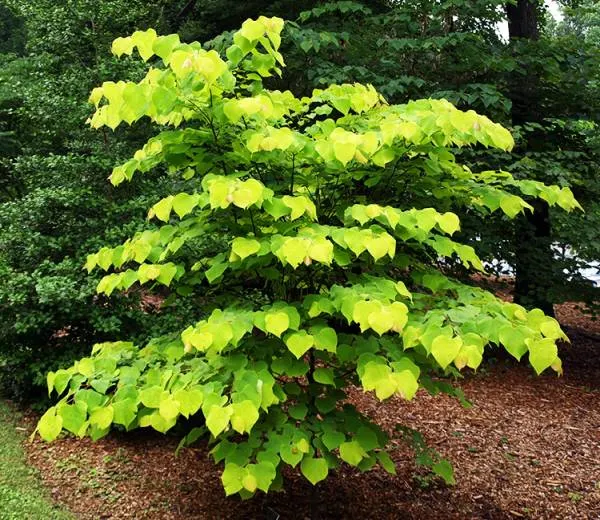
4. Henry’s Lime
Henry’s Lime tree is a botanical marvel named Tilia henryana that traces its roots back to the heart of China.
These slow-growing deciduous trees, with their distinctive heart-shaped leaves adorned with fine teeth along the edges, are a sight to behold.
As the seasons change, so do the colors of the leaves on young trees, transitioning from sea green to a golden hue in the fall. During the summer months, its fragrant pale yellow flowers grace the branches, attracting many pollinators, particularly bees.
Pro Tip: When cultivating these enchanting trees, nurture them with organic fertilizer during their formative years, as it ensures their vibrancy and health.
Characteristics
Here are some plant characteristics:
Size: It can grow 70–80 feet in height while 20–30 feet in width.
Growing zone: USDA hardiness zones 6 to 8.
Light Requirements: Henry’s Lime tree exhibits its best growth in slightly alkaline, well-drained soil.
Soil: Can flourish in both full sun and slight shade.
Beneath Henry’s Lime tree, a timeless connection between East and West continues to flourish, inviting nature enthusiasts to appreciate its beauty and grace.
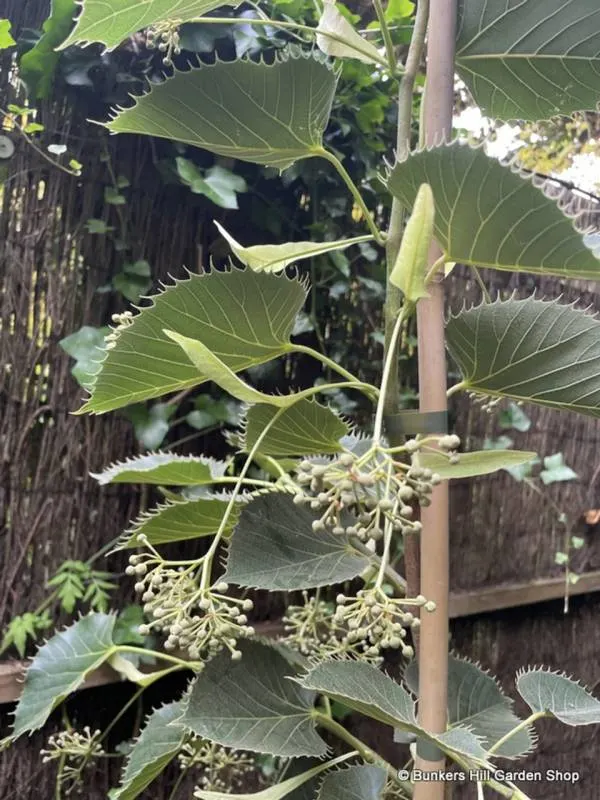
5. Italian Alder
The Italian Alder is a remarkable tree with heart-shaped leaves native to the picturesque landscapes of southern Italy and certain regions of Greece.
Its heart-shaped leaves, which can grow up to five inches long, remain glossy green for an extended period in the Northern Hemisphere, from April through December.
Not only does the Italian Alder offer aesthetic beauty, but it also boasts remarkable wind resistance, making it an ideal choice for parks and front yards.
NOTE: For those with a passion for bonsai gardening, the Italian Alder responds wonderfully to pruning and can be cultivated as a medium or large bonsai tree.
Characteristics
Here are a few plant characteristics:
Size: Up to 80 feet tall and 40 feet wide.
Hardiness Zones: Zones 5–7.
Light Requirements: Italian Alder prefers full sun to partial shade for optimal growth.
Soil: This hardy tree prefers well-drained, moist soils.
In gardens, the Italian Alder stands for nature’s beauty, strength, and ecological balance.
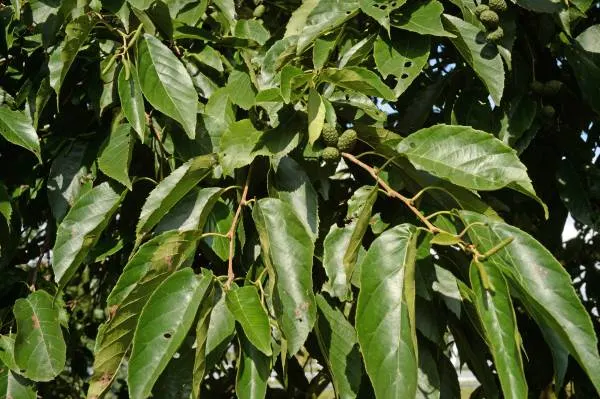
6. Katsura Tree
Katsura trees, scientifically known as Cercidiphyllum japonicum, are captivating residents of Asia, with their roots firmly planted in the landscapes of Japan and China.
These magnificent leafy trees, often with multi-trunk and brown bark, reveal their captivating tale as the seasons change.
Throughout the year, their large heart-shaped leaves steal the spotlight, displaying colors from reddish-purple to greenish-blue, coppery gold to reddish brown.
However, it’s in the cool autumn days when they really stand out, filling the air with a sweet symphony of caramel and burnt sugar as their leaves fall gracefully.
Characteristics
Here a some of the plant characteristics:
Size: 40 to 50 feet tall, 25 to 35 feet wide
Hardiness Zone: USDA hardiness zones 4 to 8
Light Requirements: It is adaptable to varying levels of sunlight
Soil: Katsura tree prefers slightly acidic, moist, and well-drained soil.
So, whether you’re seeking a touch of Asian allure or a symphony of seasonal beauty, the Katsura tree is a captivating addition to any garden.
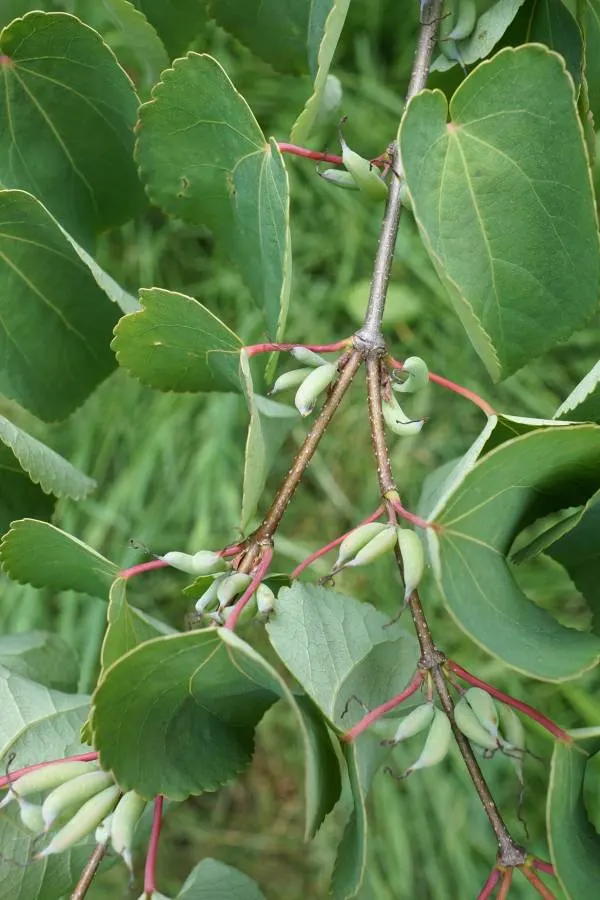
7. Northern Catalpa Tree | Cigar Tree
The Northern Catalpa tree, also known as the Cigar tree, Catawba, and Hardy Catalpa (scientifically: Catalpa speciosa), is a captivating deciduous tree native to the midwestern United States.
Catalpa trees with heart-shaped leaves and creamy white, bell-shaped flowers are a charming addition to any garden.
The Northern Catalpa trees’ bark ranges from grayish to red, adding to its visual appeal.
Whether you’re in Southern Illinois, Southern Indiana, or Northern Arkansas, the Northern Catalpa can transform your garden into a dreamy haven.
Characteristics
Here are a few plant characteristics:
Size: 40–70 feet high, 20–40 feet wide
Hardiness Zone: Zones 4–8
Light Requirements: Providing full sun to slight shade and moderate watering will ensure its healthy growth.
Soil: This tree tolerates drought and clay soils.
Incorporating the Northern Catalpa into your landscape will undoubtedly elevate its natural beauty and charm. Moreover, in addition to Nothern Catalpa trees, Southern Catalpa trees with heart-shaped leaves can also be a delight for any garden.
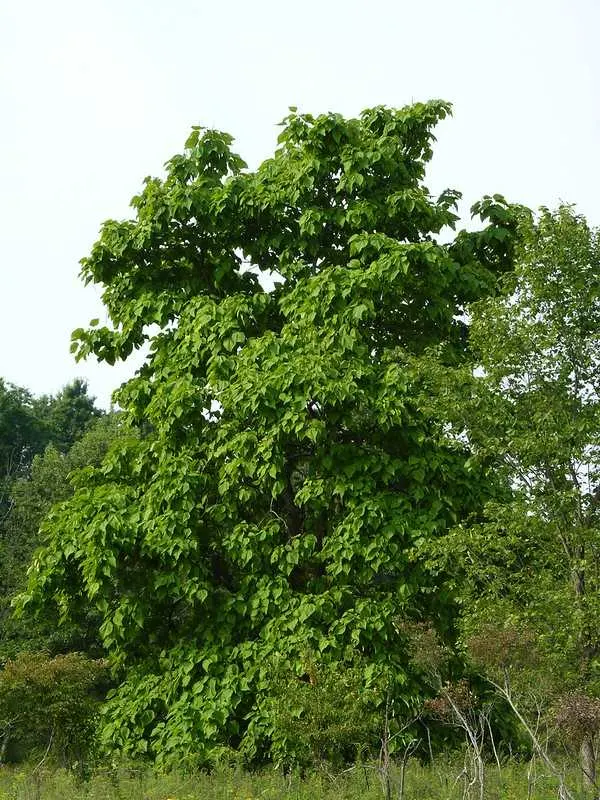
8. Quaking Aspen Tree
The Quaking Aspen, known by many names such as Golden Aspen, Mountain Aspen, and Trembling Aspen (Botanical name: Populus tremuloides), is a fascinating tree native to North America.
Their distinct pale bark adorned with dark markings and heart-shaped leaves that transform into a brilliant golden yellow in the fall make them a favorite among nature lovers. These strong trees can live for up to a remarkable 200 years, creating natural shade and beauty in any garden.
With their unique appeal and fascinating characteristics, quaking aspens are special trees that are worth taking care of.
Characteristics
Here are some of the plant characteristics:
Size: Up to 60 feet high and 20 feet wide.
Hardiness Zone: USDA zones 1 to 6.
Light Requirements: Quaking aspens demand full sunlight to flourish.
Soil: They are most content in well-drained yet moist soil.
Experience the timeless allure of these magnificent trees, known by many names but cherished by all who encounter their golden embrace.
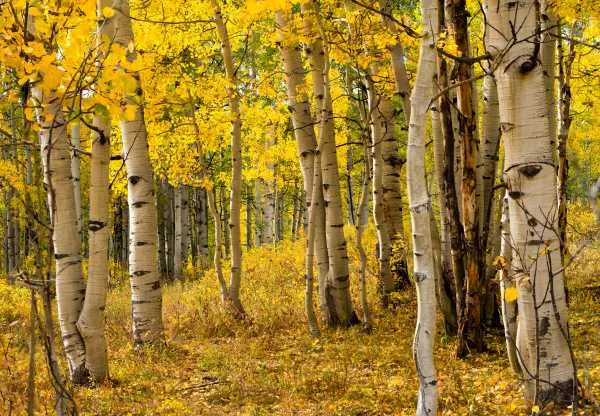
9. Southern Catalpa Tree | Indian Bean Tree
Southern Catalpa, scientifically known as Catalpa bignonioides, hails from the southeastern regions of the United States, flourishing in states like Florida, Georgia, Alabama, Mississippi, and Louisiana.
This medium-sized deciduous tree, often referred to as the Cigar, Indian bean, or Smoking bean tree, displays a striking profile with its glossy heart-shaped leaves.
In late spring, it surprises people with white, trumpet-shaped flowers that smell sweet, like jasmine.
A unique feature of this tree is its utility in traditional medicine, where its seed pods and leaves have been used for various medicinal purposes.
Characteristics
Here are a few plant characteristics:
Size: 30–60 feet tall, 20–40 feet wide.
Hardiness Zones: 5–9.
Light Requirements: It prefers moist soil and full sun to partial shade.
Soil: They prefer moist and well-drained medium to grow in.
The Southern Catalpa is a splendid addition to any scenery as it represents beauty and versatility.
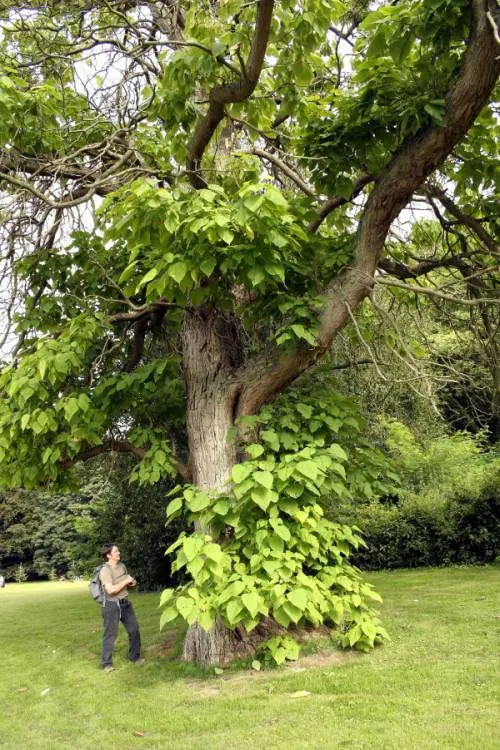
10. Silver Lime Tree
The Silver Lime or Silver Linden, scientifically known as Tilia tomentosa, is a majestic tree suitable for a range of climates from the northern parts of Idaho and New York to the southern regions of Texas.
Their heart-shaped leaves with silver undersides create a captivating display, especially when rustling in a gentle breeze.
In the early summer, the tree graces us with fragrant yellow flowers, followed by small nut-like fruits in late summer.
Characteristics
Here are some of the plant characteristics:
Size: Up to 115 feet in height and 50 feet in width or spread
Hardiness Zones: 4–7
Light Requirements: Silver lindens prefer basking in the sunlight for about 6 to 8 hours daily but can tolerate some shade.
Soil: Silver lime prefers loamy, well-drained soil.
So, welcome the silver lime tree to your space and see how it graces it with its fragrant flowers and enchanting presence.
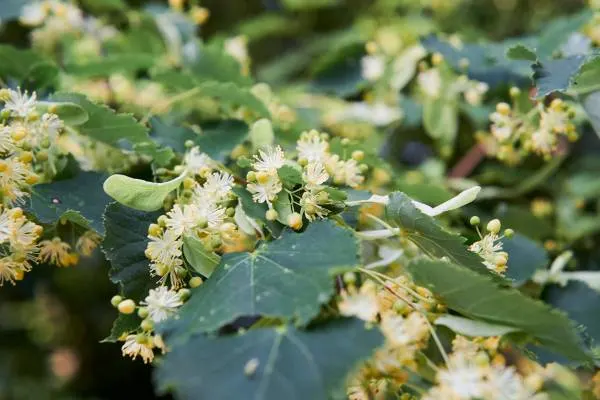
11. Western Redbud
The Western Redbud, scientifically known as Cercis occidentalis, is a fascinating addition to any garden.
These shrubs or small trees, belonging to the legume family Fabaceae, polish the lands of Southwest America, from California to Arizona and Utah, enhancing their beauty.
From March to May, Western Redbuds burst into a breathtaking display of little purple, magenta, or pink flowers that blanket every branch, making it impossible for the tree to hide its allure.
Perhaps that is why this tree is considered the ideal choice for any garden.
Characteristics
Here are a few plant characteristics:
Size: Size may vary, but typically around 6–20 feet in height and width.
Hardiness Zone: Typically in zones 7 to 9.
Light Requirements: These hardy trees thrive in bright sunlight, requiring at least six hours of direct sun daily, but can tolerate some shade.
Soil: They are adaptable to various soil types, though they prefer loam or sandy loam.
Adding Western Redbud to your garden makes it more vibrant with its colorful flowers and heart-shaped leaves.
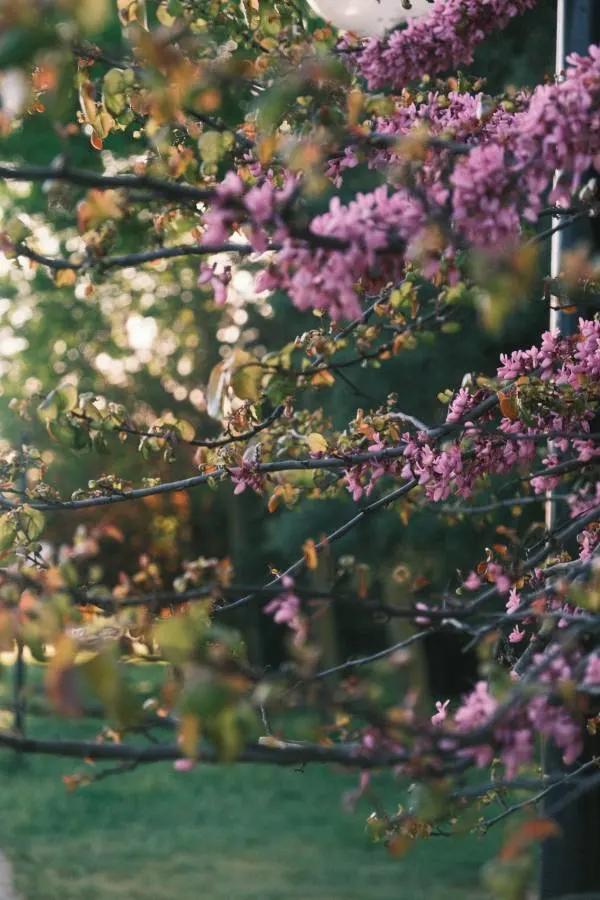
12. White Mulberry
The White Mulberry, scientifically known as Morus alba, is an alluring choice for any location.
This small to medium-sized deciduous tree possesses heart-shaped leaves that turn to vibrant yellow in the autumn, creating a stunning visual display.
Its grayish-brown bark provides an appealing contrast to its glossy green leaves.
In the spring, delicate white flowers bloom, later giving way to sweet, honey-like white fruits, which are not only a treat for humans but also attract birds, butterflies, and other wildlife.
This beautiful tree also has a rich, fascinating history in the silk industry.
It was brought to the United States to feed silkworms, and that’s why it’s also known as the “silkworm mulberry.”
Characteristics
Here are some of the plant characteristics:
Size: 40–65 feet tall, 40 feet wide.
Hardiness Zone: USDA zones 5–10.
Light Requirement: White mulberries require full sun for optimal growth and fruit production.
Soil: They will grow in clay, loam, or sandy soil, whether alkaline or acidic.
Celebrate its grace, rich history, and the delicious pies, jams, and cakes its fruits can offer.
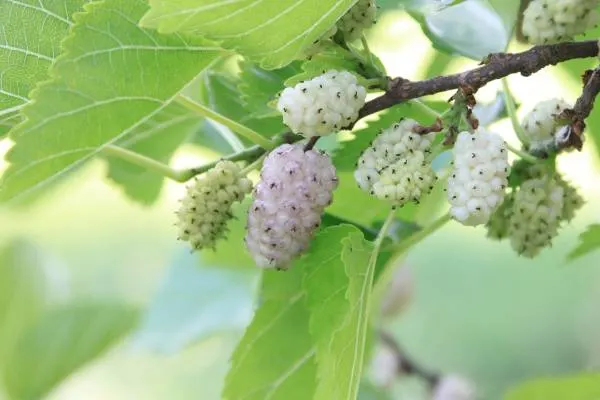
13. Yellow Catalpa
The Yellow Catalpa, scientifically known as Catalpa ovata, is a striking deciduous tree that hails from Western China.
Its large, radiant yellow-green leaves densely populate the canopy, especially when contrasted with its late spring blooms that resemble orchids.
Characteristics
Here are a few plant characteristics:
Size: 20–30 feet tall, 20 feet wide
Hardiness Zones: Zones 4–9
Light Requirements: Yellow Catalpa trees thrive in full to partial sun conditions.
Soil: It can tolerate both drought and wet soils. This tree is a true marvel, with its unique foliage, adaptable soil preferences (clay, loam, sandy), and moderate watering needs.
A living work of art, the Yellow Catalpa adds natural beauty to any landscape.
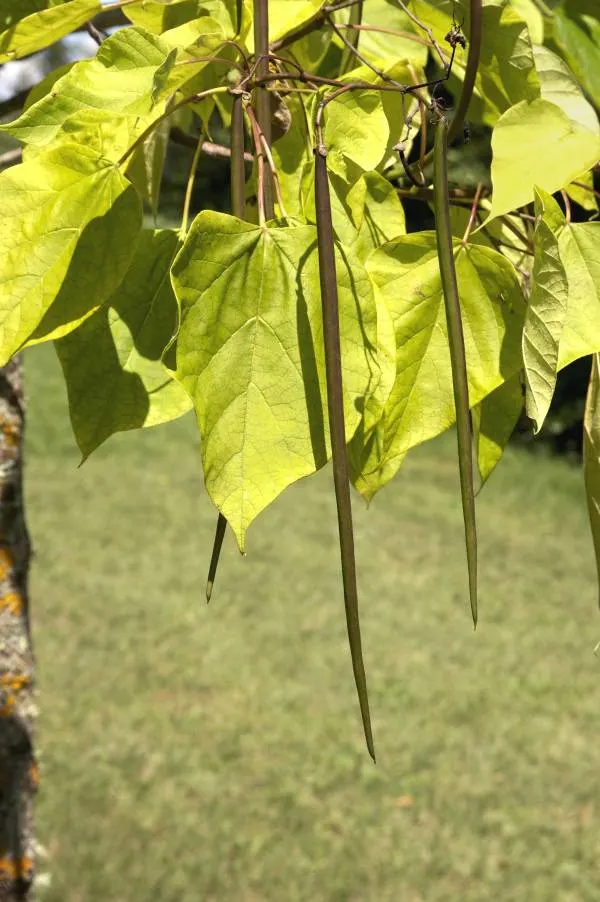
That’s all for today’s post.
Let’s head toward the conclusion.
Conclusion!
I hope you don’t need to worry about the different species of trees with heart-shaped leaves that can transform your garden into a true masterpiece of nature’s artistry.
These leaves not only add charm to the scenery but also play essential roles in biodiversity and ecological harmony. Whether you seek beauty, resilience, or historical significance, these trees have something special to offer.
Now, you’re well-equipped to make an informed choice and nurture your leafy heartthrobs to perfection.
Don’t wait any longer; start planting these captivating trees and watch your landscape flourish!
Regards,
Moiz Atiq.
